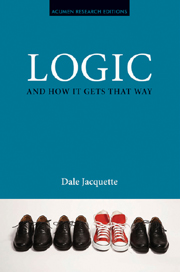Book contents
- Frontmatter
- Contents
- Preface
- Introduction: Logic, philosophy, analysis
- 1 Logical form
- 2 Monkey raisins
- 3 The secret life of truth-functions
- 4 Reference and identity
- 5 Intensional versus extensional logic and semantics
- 6 Truth
- 7 Logical and semantic paradoxes
- Conclusion: Moral lessons of logic
- Notes
- References
- Index
3 - The secret life of truth-functions
- Frontmatter
- Contents
- Preface
- Introduction: Logic, philosophy, analysis
- 1 Logical form
- 2 Monkey raisins
- 3 The secret life of truth-functions
- 4 Reference and identity
- 5 Intensional versus extensional logic and semantics
- 6 Truth
- 7 Logical and semantic paradoxes
- Conclusion: Moral lessons of logic
- Notes
- References
- Index
Summary
TRUTH FUNCTIONS
We learn about truth-functions very early in the study of symbolic logic. Propositional logic is compositional in two related ways. If we begin with atomic well-formed formulas (wffs), represented syntactically by propositional symbols, then we can build up wffs of any desired complexity by linking them together under a set of rules with certain truth-functional propositional connectives. Semantic compositionality extends the concept by implying that the meaning of a complex expression is determined by the meanings and relations holding among the expression's meaningful constituents.
The connectives defined for propositional logic are truth-functions. Propositional connectives standardly include the unary truth-function negation, and the binary truth-functions conjunction, disjunction, conditional and biconditional. These are formally defined by means of truth-tables. As functions, truth-functions transform an input or multiple inputs to a single output. The input to a truth-function consists of propositions bearing specific truth-values, and the output is a resulting complex proposition with a specific truth-value determined by the function. Mappings of all possible input and output truth-evaluated propositions are conveniently displayed in a standard truth-table, but can also be indicated without graphic devices in a metalogical language or language describing the properties of truth-functions in a logical system.
However truth-functions are characterized, they are generally considered to be so immediately surveyable and conceptually straightforward that we may find it hard to imagine that there could be anything mysterious or unanticipated in the elementary formal logic they define.
- Type
- Chapter
- Information
- Logic and How it Gets That Way , pp. 31 - 64Publisher: Acumen PublishingPrint publication year: 2010



